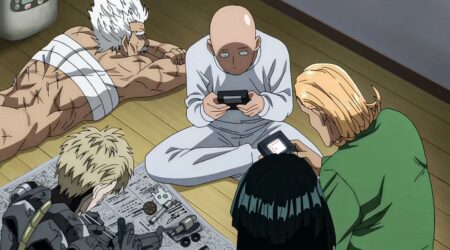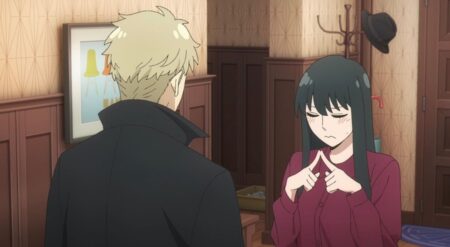The student’s UA’s Class 1-A have been through the wringer. Having continually come up against the League of Villains and been pushed beyond their limits, the students couldn’t go through much more. With Season 3 ending in emotional growth between Bakugo and Deku and the introduction to the Big Three, My Hero Academia Season 4 was had a lot to deliver on. Covering chapters 125 to 184 of the manga, this season focuses on one thing: growth.
In the standard 24-episode format, this season gives dynamic growth and episodes to characters other than our protagonist in a way I’ve rarely seen in Shonen anime. While this isn’t new for the series, My Hero Academia Season 4 seems to have showcased everything we loved about the characters and brought their true powers to the forefront. This season has three arcs that are all strikingly different in tone.
The first arc is the Overhaul arc. While the students begin their internships, a new villain arises. A Yakuza leader, Overhaul, has developed a way to remove a heroes’ quirk with one shot of a bullet. When Deku and Mirio have a chance run in with him and the young Eri, they become a part of the plan to bring him down for good. While this arc takes time to ramp up, with Deku settling into his internship under Sir Nighteye, it becomes one of the strongest arcs in the entire series once it reaches its apex.

There are shining and devastating moments for members of our Big Three, specifically Tamaki (Suneater) and Mirio (Lamillion). Additionally, Kirishima gets the spotlight for a full episode as he and his mentor Fat Gum are left to fight for their lives against two of Overhaul’s henchmen. Then, of course, you have Deku using his Full Cowl at 100% for the first time in the final fight against the big bad for the season. Each and every one of the episodes is hard-hitting and emotional and shows that My Hero Academia isn’t scared to give power to heroes other than its protagonist. Truthfully, while Deku’s moment is earth-shattering, you can’t say that he is the only star of this series, and that’s the heart of the series.
After the lull, we have the provisional license exam arc, which showcases the members of Class 1-A who weren’t featured at the beginning of the season, namely Todoroki and Bakugo. While this small arc is fluff, it does work to show the way two of the coldest members of the class have developed into empathetic and nurturing teachers in their own ways. In order to receive their licenses, the students don’t need to defeat a villain stand-in. Instead, they have to take care of a group of troubled students. Initially, it looks like a lost cause, with each potential hero not truly grasping how to meet the kids where they’re at.
But when they finally realize what they need to do, we get to see the softness and growth that both Todoroki and Bakugo have been through over the course of the seasons. Specifically, Bakugo’s words—”If you keep looking down on everyone, then you won’t notice your own weaknesses”—ground these episodes as more than a filler arc, and showcase how he, one of the strongest of students, has learned to change.

Additionally, the School Festival arc wasn’t just the lighthearted salve fans needed after an intense season, but it also showcased the dynamics between the different classes of UA and how they see the students of Class 1-A. Instead of seeing them as classmates, the other students see them as the reason behind any hardship the school has suffered.
To them, 1-A aren’t heroes; they’re nuisances, and Bakugo picks up on it quickly. Additionally, this arc shows us what everyday life can be like at UA while using traditional high school anime events. It’s a moment of happiness for the students, and as a fan, it’s reassuring to watch. Plus, we get the inclusion of two new characters, Gentle and La Brava, for heartwarming moments.
Finally, the last episodes of the season dive into the world outside of UA as we get to see the new top 10 heroes be picked for the Hero Billboard Chart, which includes Endeavor taking the place of the former Symbol of Peace as the permanent number one hero. While these episodes seem slightly detached from the previous arcs, they wrap back around the overall question that has been on the students’ minds since Kamino: Who will replace All Might? Sure, Endeavor can be the number one hero. But as an abusive father, a fearsome presence, and the fourth-ranked hero by public approval, he couldn’t possibly be the new symbol.

While I’m not a fan of the redemption arc we’ve seen Endeavor begin this season during Todoroki’s provisional license exam, the finale to My Hero Academia Season 4 made me root for Endeavor. The weight of his moments fighting a nearly unbeatable foe, the way it resonated with the crowd, pulled every emotion I had out of me. I still don’t like redemption arcs, but this one is off to a start that I can get behind.
Overall, My Hero Academia is packed with giant dynamic moments of character development that climax in high impact action sequences. But beyond that, this season excels by giving audiences an emotional core in not only the large moments of death, loss, or triumph but also in the small moments in episodes that some could consider filler. My Hero Academia Season 4 made me cry, laugh, and had me so excited that I finally began reading the manga.
You can watch all of My Hero Academia Season 4 on Crunchyroll.
My Hero Academia, Season 4
-
Rating - 10/1010/10
TL;DR
This season excels by giving audiences an emotional core in not only the large moments of death, loss, or triumph but also in the small moments in episodes that some could consider filler. My Hero Academia Season 4 made me cry, laugh, and had me so excited that I finally began reading the manga.








